Northern and arctic societies. Рубрика в журнале - Arctic and North
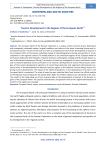
Tourism Development in the Regions of the European North
Статья научная
The European North of the Russian Federation is a unique northern (Arctic) tourist destination with ecologically vulnerable system, original traditions and culture of the locals, attracting Russian and international tourists. The aim of the work is to form a comprehensive view of the development of tourism in the European North of the Russian Federation based on identifying general trends and specifics of its development in the regional context. The model platform is six constituent regions of the European North of the Russian Federation (the Republics of Karelia and Komi, Arkhangelsk, Vologda and Murmansk oblasts, as well as the Nenets Autonomous Okrug). The research is based on investigation of seven main blocks: tourist and recreational potential and its promotion in the Internet; development of tourist infrastructure; strategies of the tourism development; dynamics of tourist flows (domestic and organized international); economic factor in the development of domestic tourism; regions in the National Tourism Rating; factors hindering tourism development. The impact of the COVID-19 pandemic on the development of tourism in the European North is presented. The study is based on open statistical data from Rosstat, the official website of the National Tourism Rating for the period 2016-2020. The median indicators are calculated in the work. The results of the study allow us to form a general idea of the development of tourism in the Russian regions of the European North. The specific characteristics and general trends of the regional development of tourism in the regions are revealed.
Бесплатно
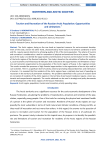
Tourism and Recreation of the Russian Arctic Population: Opportunities and Limitations
Статья научная
The Arctic regions, being on the one hand an important resource for socio-economic development of the state, and on the other hand, characterized by harsh natural and climatic conditions of work and life, require special attention to achieving quality of life of the local population. The sphere of tourism and recreation is considered as a tool for restoration of physical and emotional forces of a person. The purpose of the study is to identify the opportunities and limitations of tourism and recreation for the residents of the Arctic regions of the Russian Federation. The study is based on the calculation of indices for economic, socio-economic and infrastructural indicators that characterize the opportunities and limitations of tourism and recreation organization by the population of the Arctic regions of Russia in the regional context. The results revealed the presence of high financial opportunities in the organization of tourist trips and leisure activities. There is a significant level of activity aimed at promoting inbound domestic and international tourism. It is revealed that the residents of the Arctic regions have a relatively low level of spending on recreation in the territory of permanent residence. The problems identified in the course of research work on recreation of residents of the Arctic regions in the territory of permanent residence require a more systematic and comprehensive approach. The results obtained can be used in strategic and policy documents on the development of the Arctic regions of the Russian Federation.
Бесплатно
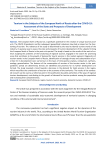
Статья научная
The European North of Russia has a significant potential for the creation of unique tourism products. The COVID-19 pandemic and the subsequent geopolitical turbulence have had an impact on the functioning of tourism. The relevance of the study is determined by the need to identify current trends of the industry. Its purpose was to assess the state and prospects of tourism development of the subjects forming the European North of Russia in the post-crisis period. The study is based on the results of the work of authors studying the problems of the functioning of regional tourism, engaged in the search for promising areas that contribute to the growth of demand for tourist services in this market segment. Diagnostics of tourism trends in the European North of Russia, identification of strategic threats and substantiation of priorities for its development were carried out on the basis of retrospective analysis, comparison, synthesis, analogy, generalization. The features of the consumption of services of the tourism sector in the post-pandemic period are determined, threats are identified and priorities for its further development are formed. The study revealed a trend towards a decrease in the demand for hotel services in the region, which may affect the contribution of tourism to the economy of the territories. The results of the conducted research can be used as a reference point in the justification by public authorities of the ways of regional tourism development, contributing to the growth of demand for tourism products among the population and increasing their competitiveness.
Бесплатно
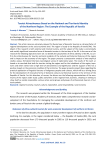
Статья научная
This article raises an extremely relevant for Russia topic of domestic tourism as a driving factor of regional development at the socio-economic level. The region of study is the Republic of Karelia (RK). The object of the research is both external and internal tourists, and the subject of the study is economically and socially significant innovative forms of domestic tourism in the territory of the RK. In the course of the research the following objectives were set: to identify the peculiarities of ethnic identity of the RK, to confirm the attractiveness for tourists and local residents of the cultural and historical features of the region and its impact on the economy of the region. The paper presents a comparative analysis of two empirical studies using a formalized interview (sociological survey of exploratory type). The results of the work allowed us to conclude that both for tourists visiting the region and for the inhabitants of the region, toponyms and other names have a high level of attractiveness and significance and the support of this has a positive impact on the economic condition of the territories. The paper presents project ideas regarding the practical application of linguistic features of indigenous peoples and cultures, which will be a driving force for the development of innovative forms of domestic cultural and historical tourism in the territory of the Republic of Karelia. For this direction, of course, the drivers are the following representatives of the community of the region under study: public authorities at the regional level; business, showing or wishing to show itself as socially responsible; various active social groups and groups of professionals; bearers of cultural symbols.
Бесплатно
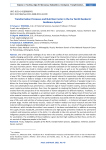
Transformation processes and nutrition factor in the far North residents' resilience system
Статья научная
One of the global challenges of our time is the conflict of man and human communities with the rapidly changing world order, which has an aspect lying at the intersection of culture and human physiology — the conformity of food behavior to lifestyle and the environment. The vitality and resilience of modern humans is subjected to special challenges. Comfortable conditions of existence in the modern world have a reverse side, expressed in diseases associated with sedentary lifestyle, psychotraumatization, violation of the usual nutrition pattern. These changes are especially noticeable on the example of indigenous peoples of the North, who have lived in relative isolation for a long time, as well as on the example of migrants forced to work in unusual natural and climatic conditions and, in general, abruptly and for a relatively short period of time (which does not allow "launching" the adaptation mechanisms) to change the whole habitual way of life. These categories of population are of special interest for researchers, including in connection with the reactions of body to changes in the food model. The idea of optimal food for the human body, formed in the course of nutriological studies, often contradicts the food traditions of peoples living in conditions far from being favourable. Since the end of the 19th century, balanced consumption of fats, proteins and carbohydrates was perceived as a civilization sign of mature modern society, and any deviations were treated as primitive practices. Over time, the approach to studying the lifestyle of traditional societies evolved from the perspective of the mechanism of human adaptation to different habitats. Traditions, including eating habits, are regarded as an optimum point of survival with the highest level of food, fuel and other material resources available in a given habitat. In addition to the problems of traditional and modernized food supply, the article focuses on the painful conditions associated with the disruption of the habitual way of life, work and nutrition of various groups of northern residents — in historical retrospect and at the present stage. Archive and literary sources, results of modern medical and social research and own field material (ethnosociological and biomedical) were used for the analysis. As a result of the generalization of the data set, which includes the authors' own research, it has been concluded that, in addition to ensuring the supply of basic foodstuffs, preventive medicines and high-quality preventive medicine for permanent residents and temporary workers in the Arctic, it is advisable to take into account the survival practices of indigenous peoples that have been developed over the centuries, creating the conditions for new settlers for assimilation. The credibility of these traditions is given by their high viability and their focus on the ethnic survival of indigenous people in the North.
Бесплатно
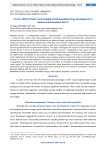
Статья научная
Iceland - an independent republic - and Greenland - an autonomous country within Denmark - represent two nations with similar geographical, economic, and historical backgrounds. Isolated from the continents, both are significantly affected by an adverse climate, making their economies dependent on trade and import. Nevertheless, despite their similarities, their national energy patterns differ substantially. Specifically, Iceland covers most of its energy mix with local renewables, whereas Greenland meets most of the energy demand with imported hydrocarbons. This paper investigates the reasons for Greenland lagging behind Iceland in terms of developing renewable energy resources. It hypothesises that, apart from the commonly-mentioned geographical, institutional, and cultural factors, the difference in social capital level has significantly contributed to the countries’ divergent energy strategies. In this sense, Iceland’s higher social capital stock stimulates its renewable power progress, whereas Greenland’s lower social capital level hampers it. To examine this hypothesis, the article constructs a ‘social capital tripod’, which assumes specific geographical, institutional, and cultural factors to be linked to renewable energy development through social capital. The findings demonstrate that Greenland, being dependent on hydrocarbon import, has a significantly lower expected level of social capital than Iceland, which runs mostly on renewables, therefore generally aligning with the research hypothesis.
Бесплатно

Статья научная
Iceland - an independent republic - and Greenland - an autonomous country within Denmark - represent two nations with similar geographical, economic, and historical backgrounds. Isolated from the continents, both are significantly affected by an adverse climate, making their economies dependent on trade and import. Nevertheless, despite their similarities, their national energy patterns differ substantially. Specifically, Iceland covers most of its energy mix with local renewables, whereas Greenland meets most of the energy demand with imported hydrocarbons. This paper investigates the reasons for Greenland lagging behind Iceland in terms of developing renewable energy resources. It hypothesises that, apart from the commonly-mentioned geographical, institutional, and cultural factors, the difference in social capital level has significantly contributed to the countries’ divergent energy strategies. In this sense, Iceland’s higher social capital stock stimulates its renewable power progress, whereas Greenland’s lower social capital level hampers it. To examine this hypothesis, the article constructs a ‘social capital tripod’, which assumes specific geographical, institutional, and cultural factors to be linked to renewable energy development through social capital. The findings demonstrate that Greenland, being dependent on hydrocarbon import, has a significantly lower expected level of social capital than Iceland, which runs mostly on renewables, therefore generally aligning with the research hypothesis.
Бесплатно
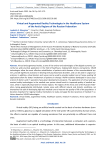
Статья научная
Virtual and augmented reality, as one of the end-to-end technologies of the digital economy, currently has wide practical application in the field of healthcare, helping both doctors and patients. VR/AR technologies allow the most effective rehabilitation of patients with diseases of the musculoskeletal system, provide significant assistance in dealing with psychosomatic disorders, and can be used in surgical operations. In addition, virtual doctors and nurses can be used to provide medical care at home; existing VR applications allow for better involvement of patients in therapy. VR/AR solutions developed in close cooperation of doctors and IT specialists have great development prospects. The application of virtual and augmented reality technologies in the medical care system should result in improved quality of medical services, which is especially important for remote regions. The regions of the Arctic zone of the Russian Federation, being geographically distributed, remote areas with difficult natural and climatic conditions, set themselves the task of developing high-tech medical care to improve the quality of life of the population. It becomes important for regional medical institutions to study and apply the best practices of medical IT solutions based on VR/AR technologies.
Бесплатно
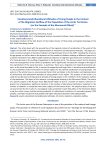
Статья научная
The article deals with the peculiarities of the regional context of socialization of the youth of the subjects of the AZRF in the field of implementation of vocational and educational attitudes. The paper presents a summary analysis of statistical indicators of migration gain (loss) in the AZRF, including the structure by age groups, as well as data on the dynamics of the number of students studying at different types of educational institutions from 2005 to 2020. Statistical indicators of migration gain (loss) have revealed a trend of a sharp decrease in the outflow of population in the Russian Arctic. The obvious reasons for this situation were the consequences of the COVID-19 pandemic, which significantly increased the changes in the logic of the reproduction of the social structures, in particular, there was a migration turn towards provincial subjects, as the most favorable for life, in contrast to megacities and large cities. It actualizes and problematizes the possibilities of the environment of remote regions for the optimal socialization of young people. The authors of the article focus on environmental factors that contribute to the formation and implementation of professional and educational attitudes of young people in the region. The purpose of the article is to study the professional and educational attitudes of young people in the conditions of the migration outflow of the population. The object of the research is young people studying in the Murmansk Oblast. The choice of a specific subject of the Russian Arctic (Murmansk Oblast) is due to a number of reasons: intensive migration loss of population; significant reduction in the number of educational institutions; reduction in the number of students in comparison with other subjects of the Russian Arctic. The empirical basis of the article was formed by the results of a sociological study conducted in April–May 2021 in the Murmansk Oblast using the online survey method among graduates of educational institutions of secondary general (523 people), secondary vocational (519 people) and higher education (bachelor level) (283 people).
Бесплатно
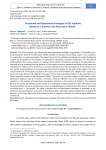
Vocational and Educational Strategies of SVE Students (Based on a Survey in the Murmansk Oblast)
Статья научная
The article analyzes the educational and professional strategies of graduates of secondary vocational education (SVE) of the Murmansk Oblast, formed on the basis of prevailing values in the conditions of socialization in a particular region. The paper focuses on the existing contradictions in understanding the reasons for the growth in the number of applicants to secondary vocational institutions. On the basis of statistical data from various sources, an analysis of the system of vocational training at the secondary professional level is presented and the features of the human resources potential and needs of the region are indicated. The authors of the article focus on environmental factors that contribute to the formation of values and the implementation of vocational and educational strategies for the youth of the region. The theoretical framework of the study is based on the social constructivism theory of P. Berger and T. Lukman, as well as the value theory of R. Inglehart. The object of the study is graduate students in the secondary vocational education system of the Murmansk Oblast. The choice of a specific subject of the Russian Arctic (Murmansk Oblast) is due to a number of reasons: intensive migration loss of the population; significant reduction in the number of educational institutions; reduction in the number of students. The empirical base of the article was formed by the results of a sociological study conducted in April-May 2021 in the Murmansk Oblast by online questionnaire survey among graduates of educational institutions of secondary vocational level — 519 people. The study of professional and educational strategies of graduates of secondary vocational education, an analysis of educational plans, attitudes towards employment, including the direction of training, labor value orientations as well as migration attitudes of students were additionally considered.
Бесплатно
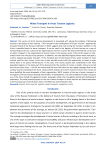
Water Transport in Arctic Tourism Logistics
Статья научная
The success of Arctic tourism development is associated with solving the problem of delivering tourists to the places of their interest. “The Concept for the Development of Cruise Tourism”, approved by the government of the Russian Federation in 2022, suggests that overcoming the transport problem in the Arctic is possible thanks to water transport. It can be used in the logistics of Arctic tourism as a way of transporting tourists on routes and for organizing sea and river cruises. We have examined the current use of water transport in the organization of tourist routes in the Russian sector of the Arctic based on information from river and sea cruise operators. In addition, we have identified regions where water transport is used to organise passenger transport. In the European part of the Russian Arctic, water transport is most actively used for river cruises. Arctic river cruises provide tourists with the opportunity to travel in areas where there is no special infrastructure. In this case, river routes usually start southwards in the most populated regions. In the Asian part of the Russian Arctic the number of cruises is smaller, they are carried out only on three rivers — the Ob, the Yenisei and the Lena. But there are also regular passages that can be used by tourists travelling to the Arctic. Using content analysis of tourists’ reviews of Arctic river cruises we have identified the main drawbacks of their organization. SWOT analysis of the use of water transport in the logistics of Arctic tourism showed what hinders its development. The main problems of water transport use in the Arctic include the ageing of vessels, passenger safety, short navigation period and shallowing of waterways. The most promising ways for the use of water transport in Arctic tourism are inland waterways in the European part of the Russian Arctic, the White Sea and the Barents Sea.
Бесплатно
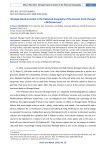
Wrangel island as actant in the historical geography of the Russian Arctic through a Mi’kmaw lens
Статья научная
Wrangel Island is the largest island in the Russian Eastern Arctic and is now a protected place with international recognition. One of only five UNESCO world heritage sites in the Arctic, Wrangel Island is uniquely varied in its flora and fauna for an Arctic island. In this reflection piece, I use an Indigenous Mi’Kmaw cosmological approach to envision the much-storied Wrangel Island as a being and an actant in its long history, especially regarding human beings and anthropocenic activity. My approach asserts that, like plants, rocks, mountains, water, and landscapes, Wrangel Island has a unique and remarkable identity, personality, and spirit. For centuries, Wrangel Island has rebuffed human presence and it has been little affected by human activity. Today only scientists visit; no human collectivity has ever gained more than a slippery grip on the island. The tragedy is that, despite the island’s inclinations, the warming of the Russian Arctic may change this.
Бесплатно
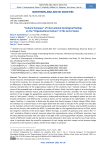
Статья научная
The article is devoted to a comparative analysis of open data from international sociological Internet resources (Trompenaars Hampden-Turner Connecting Viewpoints, Hofstede Insights Ltd) in relation to the Arctic countries. As it is known, the models of F. Trompenaars, G. Hofstede are focused on the study of differences in business cultures and the analysis of cross-cultural communication, i.e. the study of the national characteristics of the organizational culture of the countries, their “cultural compass”. The relevance of the proposed topic is dictated by a number of factors: firstly, the Arctic region is an area of geopolitical competition between Russia and predominantly Western countries; secondly, the most important element in the struggle for geopolitical supremacy is “organizational culture” as the most important element of “soft power”; thirdly, it is important to understand how Western sociological models see the relationship (similarities and differences) of cultural factors on the example of key stakeholders in the Arctic region; fourthly, it is important to determine the place that Russia occupies in these ratings; fifthly, Western attempts to constrain Russia in the region determine the need to include in the sample not only data on the members of the Arctic Council (represented, with the exception of Russia, only by NATO countries), but also on Russia’s allies within the BRICS, in particular data on the organizational culture of China, which has long-term interests in the Arctic region. Within this logic, a number of questions arise: what is the “vision” created by Western Internet resources about the organizational culture of different countries, how the data obtained correlate with each other in the light of the current geopolitical situation. Comparing the results of different models and the statistical results obtained on their basis can lead to non-trivial conclusions, in particular about the scientific component of such ratings and their impact on the business image of countries in the world as a whole, and the Arctic region in particular.
Бесплатно
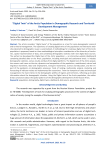
Статья научная
The article considers “digital twins” of the population as a tool for socio-demographic research and territorial management. The experience of creating digital twins of the population and interactive websites devoted to demographic issues is systematized. A methodology for creating a digital twin of the Arctic population is proposed, based on three methodological principles: consideration of the hierarchy of territories, spatial representation of data, and combining demographic statistics with new digital data sources. The author has developed the Digital twin of the Arctic population — an interactive website (dashboard) containing detailed data on the Arctic population, including municipal and settlement levels. It includes demographic statistics, census results and data from digital platforms. The Digital twin of the Arctic population covers such issues as the size, dynamics and composition of the population, resettlement, natural and migration movement, labor and employment, transport movements, science and education, and the impact of the pandemic on demographic processes. Tools of ranking, multivariate analysis, clustering and forecasting of indicator values are implemented for researchers. From the viewpoint of state and municipal management, the main interest is the demographic profiles of regions and territories, reflecting up-to-date information about the demographic situation. Using the Digital twin of the Arctic population, the author draws conclusions about the spatial patterns of the demographic development of the Russian Arctic.
Бесплатно

Статья научная
The article is devoted to the socio-economic adaptation of single-industry towns’ population on the example of single-industry settlements in the North-West of Russia. The work’s theoretical and methodological framework is the approaches of scientists who study the grassroots practices of survival of small towns and villages (seasonal work, commuting, a distributed way of life, the informal economy). The empirical base of the study are statistical data collected from the databases of EMISS, SPARK Interfax, the Foundation for the Development of Single-Industry Towns, websites of administrations of single-industry settlements in the Northwestern Federal District, as well as data from field studies collected by the method of semi-formalized interviews with representatives of administrations and deputies of city and regional councils, with ordinary residents of single-industry towns in Republic of Karelia, Leningrad and Vologda oblasts. The study’s preliminary results are presented: first, an analysis of the contradictions in the management approach. Many single-industry settlements in the Northwestern Federal District do not meet the criteria according to which they are included in the official list of single-industry towns. Also, government support measures to rescue “dying” monotowns are ineffective. Secondly, empirical research results show that residents of single-industry towns have developed strategies for adapting to new socio-economic conditions of life, which are not associated with employment in a city-forming enterprise. These strategies include: 1) rotational work or seasonal work; 2) pendulum migration within spontaneous local agglomerations; 3) “distributed lifestyle”; 4) involvement in various spheres of the informal economy. Thus, single-industry towns “do not die” but survive primarily due to the population’s grassroots economic practices.
Бесплатно

